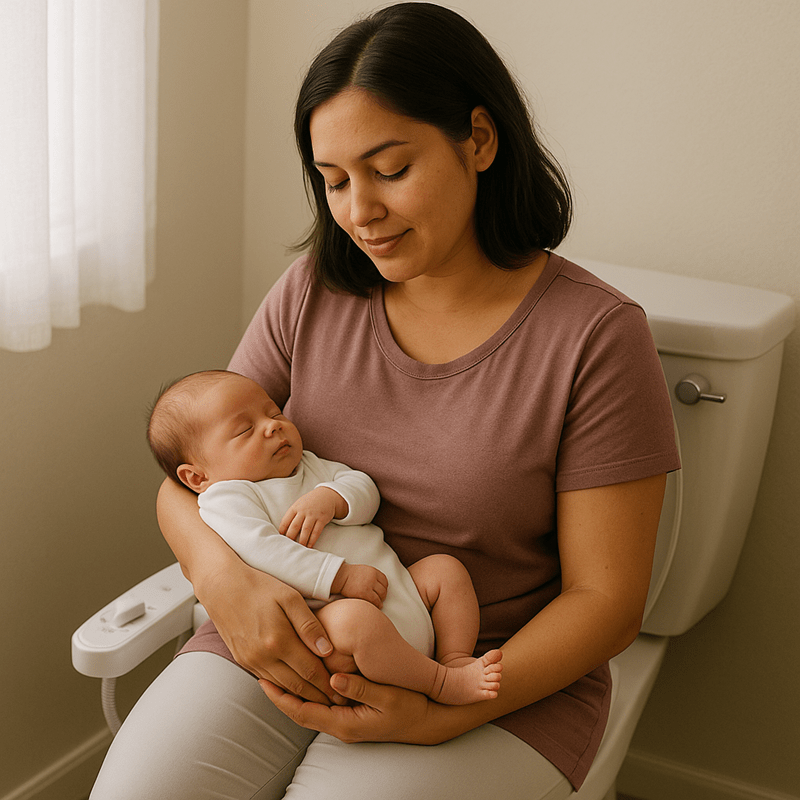
Introduction to Postpartum Recovery
The journey of childbirth is a transformative experience, but it also brings about significant physical changes and challenges for new mothers. Postpartum recovery is a critical phase where the body heals and adjusts after the rigors of pregnancy and delivery. During this time, many women seek effective ways to manage discomfort and promote healing. One such method gaining popularity is the use of bidets. These fixtures, which are standard in many parts of the world, offer a range of benefits that can aid in postpartum recovery. This blog post will explore the advantages of bidet use for new mothers, providing insights into how they can support physical comfort and hygiene during this delicate period.
Effect of Bidet on Urinary Tract Infection Prevention 👆Understanding Postpartum Challenges
After childbirth, women face a multitude of physical challenges. These can include perineal soreness, hemorrhoids, and the delicate healing of any stitches from tears or episiotomies. The postpartum period also involves lochia, a discharge of blood and mucus from the uterus that can last for several weeks. Managing these aspects of recovery requires careful attention to hygiene and comfort. Traditional methods of cleansing can sometimes exacerbate discomfort or pose risks of infection. Therefore, many healthcare professionals recommend gentle and effective alternatives to standard toilet paper and wipes, which is where bidets come into play.
How Bidet Use Helps Alleviate Anal Itching 👆Hygiene Benefits of Bidets
Reducing Infection Risks
One of the primary benefits of using a bidet during the postpartum period is its superior hygiene capability. Bidets provide a gentle stream of water that can clean the perineal area more thoroughly than toilet paper alone. This is particularly important because the risk of infection is heightened during postpartum recovery. The gentle cleansing action of a bidet can help remove bacteria and reduce the risk of urinary tract infections (UTIs) and other complications. The water stream rinses the area without the friction that toilet paper can cause, minimizing irritation and promoting a more comfortable healing process.
Enhancing Personal Comfort
For new mothers dealing with sensitive perineal tissues or hemorrhoids, the use of a bidet can be a game-changer in terms of comfort. Unlike toilet paper, which can be abrasive, the soft flow of water from a bidet is soothing and gentle. This is especially beneficial for women who have undergone episiotomies or have experienced tears during childbirth. The water’s soothing properties can help alleviate discomfort and provide a sense of relief, making the daily process of personal hygiene more comfortable and less painful.
Impact of Bidet Use on Hemorrhoid Prevention 👆Promoting Healing
In addition to providing superior hygiene, bidets can also facilitate faster healing. The warm water from a bidet can promote increased blood flow to the perineal area, which is essential for healing. Enhanced circulation helps deliver oxygen and nutrients to the tissues, accelerating the recovery process. Moreover, the regular use of a bidet can prevent the buildup of bacteria that might otherwise impede healing and lead to infections. By maintaining a clean and healthy environment, bidets support the body’s natural healing mechanisms, allowing new mothers to recover more swiftly and comfortably.
Classic Quality Meets Modern Innovation: Discover American Standard Bidets 👆Environmental and Practical Considerations
Sustainability and Cost-Effectiveness
Beyond the personal health benefits, using a bidet is also an environmentally responsible choice. Bidets significantly reduce the need for toilet paper, which is advantageous not only for the environment but also for household budgeting. The production and disposal of toilet paper contribute to deforestation and waste, while bidets offer a sustainable alternative. For families welcoming a new baby, every cost-saving measure counts. The initial investment in a bidet can lead to significant savings over time, as the reduced use of paper products lowers household expenses.
Ease of Use and Accessibility
Modern bidets are designed with user-friendliness in mind, making them accessible for people of all ages and physical abilities. For postpartum mothers, who may find bending or reaching difficult, the convenience of a bidet can be invaluable. Many models come with features such as adjustable water pressure and temperature, making them customizable to meet individual comfort needs. Some bidets even offer air-dry functions, further enhancing the hygiene process without the need for additional paper or towels.
Transform Your Bathroom Comfortably with SmartBidet 👆Choosing the Right Bidet
With various types of bidets available on the market, selecting the right one for postpartum use is important. Options range from standalone bidet fixtures to bidet attachments that can be easily installed on existing toilets. When choosing a bidet, consider factors such as ease of installation, available features, and budget. Some bidets offer advanced features like heated seats, oscillating wash functions, and remote controls, which can enhance the user experience. It’s also wise to read reviews and perhaps consult with other mothers who have used bidets during their recovery to gain insights and recommendations.
From Classic to Cutting-Edge: Kohler’s Bidet Revolution 👆Conclusion: Embracing Bidet Use
Bidets offer a multitude of benefits that can greatly enhance the postpartum recovery experience. From superior hygiene and comfort to promoting faster healing, these fixtures provide practical and environmentally friendly solutions for new mothers. As awareness of the advantages of bidet use grows, more women are embracing this tool as a critical component of their postpartum care routine. By investing in a bidet, mothers can support their physical well-being and focus on the joys of nurturing their newborns without the added discomfort and challenges that traditional hygiene methods may present. As you consider your postpartum recovery plan, think about how a bidet might fit into your lifestyle and contribute to a smoother, more comfortable recovery journey.
Related Posts: Impact of Bidet Use on Hemorrhoid Prevention
No Electricity No Problem: Meet LUXE Bidet 👆